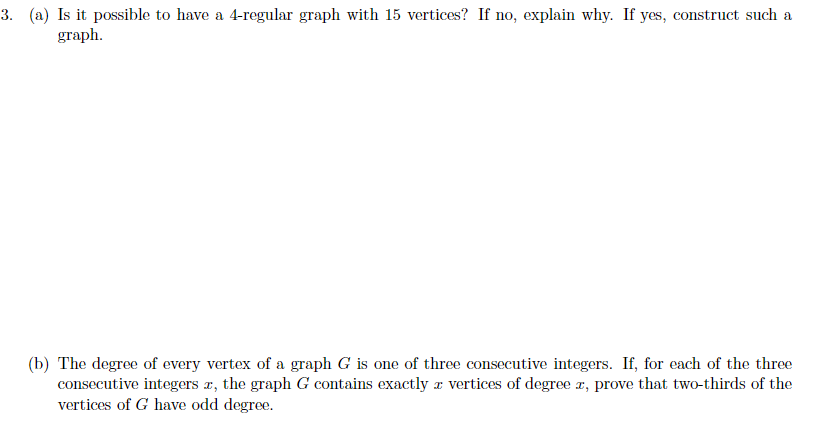3. (a) Is it possible to have a 4-regular graph with 15 vertices? If no, explain why. If yes, construct such a graph. (b) The degree of every vertex of a graph G is one of three consecutive integers. If, for each of the three consecutive integers æ, the graph G contains exactly x vertices of degree a, prove that two-thirds of the vertices of G have odd degree.
3. (a) Is it possible to have a 4-regular graph with 15 vertices? If no, explain why. If yes, construct such a graph. (b) The degree of every vertex of a graph G is one of three consecutive integers. If, for each of the three consecutive integers æ, the graph G contains exactly x vertices of degree a, prove that two-thirds of the vertices of G have odd degree.
Linear Algebra: A Modern Introduction
4th Edition
ISBN:9781285463247
Author:David Poole
Publisher:David Poole
Chapter3: Matrices
Section3.7: Applications
Problem 80EQ
Related questions
Question

Transcribed Image Text:3. (a) Is it possible to have a 4-regular graph with 15 vertices? If no, explain why. If yes, construct such a
graph.
(b) The degree of every vertex of a graph G is one of three consecutive integers. If, for each of the three
consecutive integers r, the graph G contains exactly r vertices of degree r, prove that two-thirds of the
vertices of G have odd degree.
Expert Solution
This question has been solved!
Explore an expertly crafted, step-by-step solution for a thorough understanding of key concepts.
This is a popular solution!
Trending now
This is a popular solution!
Step by step
Solved in 3 steps with 1 images

Recommended textbooks for you

Linear Algebra: A Modern Introduction
Algebra
ISBN:
9781285463247
Author:
David Poole
Publisher:
Cengage Learning

Algebra & Trigonometry with Analytic Geometry
Algebra
ISBN:
9781133382119
Author:
Swokowski
Publisher:
Cengage

Linear Algebra: A Modern Introduction
Algebra
ISBN:
9781285463247
Author:
David Poole
Publisher:
Cengage Learning

Algebra & Trigonometry with Analytic Geometry
Algebra
ISBN:
9781133382119
Author:
Swokowski
Publisher:
Cengage